
|
Two Marvelously Weird Ciliates Blepharisma and Climacostomum by Richard L. Howey, Wyoming, USA |
Imagine a micro-vacuum cleaner and a pink cannibal and you have a hint of the weirdness of Climacostomum and Blepharisma. However, before we get to the good stuff, I’m going to start with (as is often the case) a digression which you are free to ignore (however, that wouldn’t be the case if I were still teaching and you were one of my students!) I’ll create a separate section clearly marked, after my digression when I return to the 2 beasties under consideration, so that you can skip all the intervening kvetching and get right to the microscopic stuff. I have been planning this essay for some time in a somewhat different form than when I first conceived it because in the meantime there was an “event” which on an historical scale of 1 to 100 rates a 0.00001in terms of significance, but on my day-to-day egocentric scale, it ranked about 95.27349–in other words, it was damned important to me.
I was sitting in my study upstairs, working on my computer on a warm, late summer day–September 19, 2009. I had an oscillating tower fan running to create a bit of air circulation when I heard an odd clicking creaking sound and I thought the fan was giving out, so I immediately used the remote control to turn it off. It occurred to me that I had heard the same sound the two previous days and I resigned myself to buying a new fan. I turned back to my computer but the creaking sound got louder and I looked up just as half of the ceiling in the room collapsed, narrowly missing me, but landing on my computer, two microscopes, a micro-manipulator, two fiber optic illuminators, books, a stereo system, CDs, and notebooks and papers. I pushed to the very limits my vocabulary of four-letter words and sat stunned for about 2 minutes in a white cloud of plaster dust. Coal miners (who were often minors) used to get “black lung”; I suspect I now have “white lung.” I finally rallied myself enough to shout down to my wife that she should come upstairs. The arthritis in her knees had been bothering her for a few days and she asked: “Is it really necessary?” To which, I, in what I regarded as a most temperate and civilized fashion, replied: “I think it might be.” She dutifully trudged up the stairs and when she got to the top, she queried: “Smoke?” She wasn’t inquiring whether or not I was having a cigarette, cigar, or pipe, because I had quit smoking 20 years ago. I suspect that she thought I had been conducting some bizarre experiment in my lab across the hall and generated some noxious fog. I waved her into my study; she stood silent for about a minute, said “Oh My God!”, was as stunned as I was, and then walked away back downstairs.
My senses gradually returned and I closed off my study so that the cats couldn’t wander in and get plaster dust all over their paws. However, we all got some of it, since the white cloud–a new strategic weapon for the Pentagon–had spread throughout the entire upstairs. Our house is 120 years old and we live in a location with very little humidity, so over the years, the ceiling had apparently dried out so that the wallpaper could no longer support the plaster and the sky came tumbling down–at least that’s what the contractor and insurance company told us. The contractor who had put a new roof on our house the previous October certainly didn’t want to entertain even the remotest possibility that he and his crew stomping around, tossing bundles of shingles, and using nail guns could have in any way contributed to this highly disruptive mess–and perhaps (possibly, maybe) he was right. Odd things happen to old houses and old people as the insurance agent assured me. The agent informed me that aging of a property was an exclusion and thus not covered under ordinary circumstances. He also told me that he would be glad to file a claim on my behalf, if that’s what I decided I wanted to do, but that such a claim might very well not only be denied, but result in an increase in our deductible payment. Sometimes, I get the feeling that this is the way health insurance is skewed as well in this country; the older you get the more things are excluded.
Now, I do admit that both my wife and I are, in large part because of our wide range of interests and intense curiosity, outrageous accumulators of STUFF! However, in our defense, I must say that much of what we acquired over the last 50 years had relevance, directly or indirectly, to our teaching. But enough description, I’ll show you a few pictures of the “event”.






These do, I think give a fairly good idea of the mess with 2 significant exceptions: 1) The cloud of plaster dust spread like an insidious miasma throughout the entire upstairs floor, seeping under doors, into storage drawers, cabinets, leaving a thin layer of deposit on every book ,every specimen bottle, every item of clothing, and every piece of paper. Just prior to the collapse, I had been working on 3 different microscopes in two different rooms and so they didn’t have their usual protective plaster covers over them, since I was planning to use the computer only rather briefly to look up some information on the organisms which I had been studying and then planned to return to the microscopes. So trying to clean the lenses on these instruments has been an especially long and tedious nightmare, but even the instruments that were covered still had to be carefully and scrupulously cleaned. 2) Very old plaster dust is, especially from a microscopist’s point of view—anathema; it is abrasive, it consists of very fine particles, it drifts readily, and the slightest bit of moisture turns it into a kind of sticky paste. To use canned air results in simply spreading it around again, dry wiping removes part of it, but then another wipe with a slightly moist towel (preferably microfiber) is necessary and even then, traces remain. After waiting 10 weeks after the “event”, the contractors restored the ceiling and left us to the reconstruction effort. Everything I touch leaves a film of the evil dust on my fingers and hands and the tiresome precess of wiping, cleaning, and reorganizing has made me fervently wish for a Harry Potter wand with which I might, with one or two waves, restore some semblance of order. So, what does all of this have to do with Blepharisma and Climacostomum?
Back To The Beasties: For the Impatient Readers.
I do have to tell you one more thing about the restoration project of the ceiling for it has a direct bearing on something rather interesting which I discovered about these two organisms. The staircase up to the second floor is very narrow and there is a 90 degree turn at the landing and another 90 degree turn at the top and then about 40 feet down to the room where the ceiling fell in. At the top of the stairs, I have bookcases, small cabinets, reagents, specimens, cultures and other assorted miscellanea that the amateur microscopist (natural historian) accumulates. So, imagine the problems which the workmen faced moving 8 foot by 4 foot sheets of drywall through this maze of clutter. What they did, of course, was rearrange half of this stuff and when they were through trundled away without putting anything back, essentially blocking my access to that lab area and its four microscopes. This was a problem which I needed some help to resolve with my decaying spine and my wife’s arthritis, especially since one of the cabinets was a heavy, metal (not Heavy Metal) watchmaker’s cabinet. After a few weeks, I finally found a student to hire who helped me regain my lab area and a small portion of my sanity.
Now, all of
this truly is relevant to Blepharisma
and
Climacostomum
because
that area was where my 8 small culture dishes (4 of each organism)
were and I was concerned that I had completely lost all of my
specimens. I was madly hoping that they hadn’t dried up
completely even though it seemed likely.
I began with the Climacostomum; I put the first dish under my stereo dissecting microscope–bone dry. Not at all encouraging. However, the second, third, and fourth dishes each still had a thin film of water on the bottom and I was able to see a significant number of cysts in each. One of the helpful characteristics of both Climacostomum and Blepharisma is that they form distinctive cysts.
The top image is of Climacostomum cysts and the second image is of Blepharisma cysts.


I immediately added some artesian water and cut wheat grains to each dish. I didn’t have any dried, boiled wheat grains, so I took some ordinary ones–not wanting to risk delay–and cut each one in half using a pair of small bone cutters which I reserve for this purpose.
Three days later, with some trepidation, I examined the dishes again (Here we need an orchestral background to indicate the rise of almost intolerable tension.)
I took the top dish of Climacostomum –an aquatic desert. (I know that’s an oxymoron, but it gets the idea across.) I checked the label and this was the dish which had completely dried up, so a faint glimmer of hope remained. In the second dish, I found 3 specimens; in the third dish 5 specimens and, in the fourth dish, about a dozen specimens. There were also still a significant number of cysts, so I was hopeful that I would soon have Climacostomum in abundance again.
Mildly encouraged, I turned to the four Blepharisma which I had attempted to salvage in the same way. Again, I started with the one which had completely dried up and, as I expected, only some cysts and no active organisms. The other 3 dishes were a pleasant surprise–abundant Blepharisma in all three. This was especially important to me because this organism is truly bizarre in the Hall of Weird Organisms.
Finding significant blocks of time to study these remarkable beasties was difficult given that we were trying to restore order to almost half of the house and moving boxes of things from the garage back to the upstairs, others to the downstairs, boxes from the upstairs down to the basement, boxes from the basement to the upstairs–in other words, a continuing confusion worthy of a scene from Lewis Carroll. The delays prompted me to make 4 more subcultures–2 of each organism–to try to insure that I had enough specimens to carry me through my initial set of observations
Let’s start with Climacostomum–the micro-vacuum cleaner. (I’m going to try to develop a strain that eats plaster dust.) These are fairly hardy creatures and while they can be strong swimmers, they seem to prefer grazing on detritus in the substrate.

As you can see, they are slightly elongated ovoids with a bit of a curve in the upper anterior third which sets the cytostome off at a slight angle (which is probably better for vacuuming in corners). If you show this organism to friends untutored in the delights of microscopy, he or she may very well ask: “But what does it do? What good is it? What’s it for?” These kinds of teleological questions are ones that on some days can almost make me forget that I am a gentleman (supposedly) and I am tempted to respond caustically “What do you do? What good are you? What are you for?” We blithely assume that we are indeed worth something and have some special purpose and value, but without much justification and, in my most cynical moments, I’m perhaps more disposed toward the idea that an Atlas moth or a Heterocentrotus mammilatus (sea urchin) or a lady slipper orchid has more of a purpose than teleological-minded humanoids.



And what would that purpose be? The answer is quite simple: a ploy by Mother Nature to get us slow-witted human beings to ask stupid, irrelevant, unanswerable questions!
Climacostomum is an ecological opportunist. In the environments it prefers, it’s hard to run out of food stuffs, namely, bacteria. This organism has an elongated, curved, heavily ciliated cytostome (mouth) which leads to a gullet where food vacuoles are formed. It also possesses a distinctive band-shaped, curved and folded macro-nucleus. One afternoon, I took a sample from one of my revivified cultures and feeling adventurous, I decided to take some images using Nomarski DIC on my scrupulously twice-cleaned, and I hoped free-of-plaster dust lenses, on my large Reichert compound microscope. Fortunately, the Greek goddess of small things magnified, Mikroskopia, was in harmony with me on that particular day and as I experimented with the prism, I ended up with some results that I immodestly say pleased even me. The following are all of a single living specimen using Nomarski DIC with the prism set at a variety of different positions to create “optical staining”.

This image clearly shows the funnel-shaped cytostome an the spiral ciliary bands on the surface of the membrane.
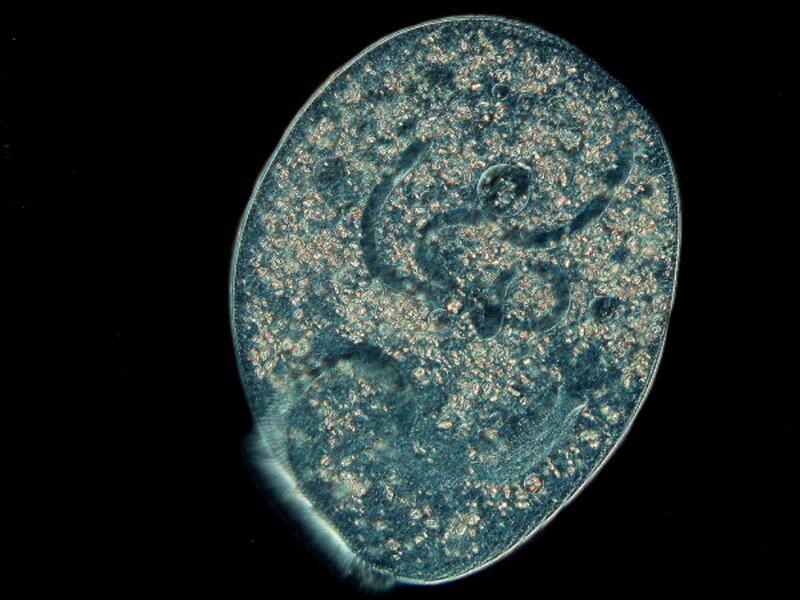
In the upper half, you can see the band-shaped macronucleus with it’s loops and along the lower edge you can see the band of cilia along the cytostome.
The next two images show “optical staining” using Nomarski Differential Interference which also employs polarization which aids in revealing the many small birefringent crystals in the cytoplasm.
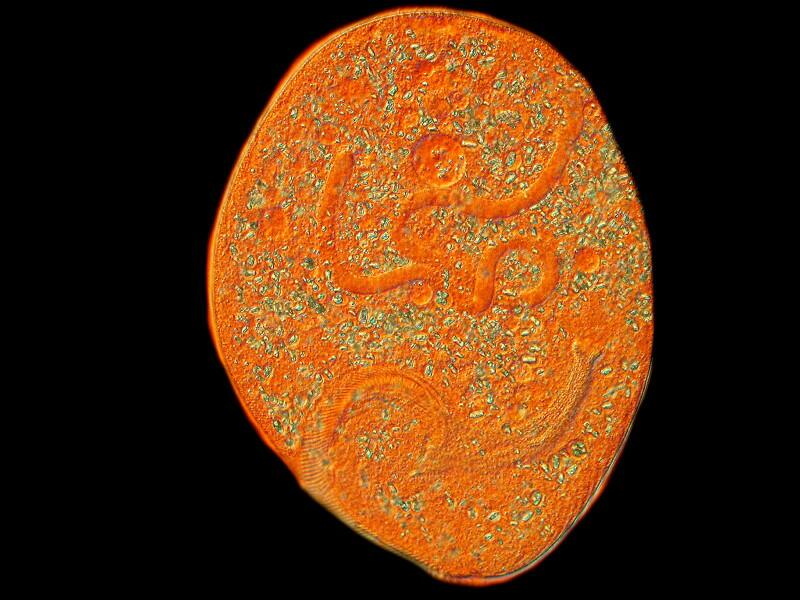
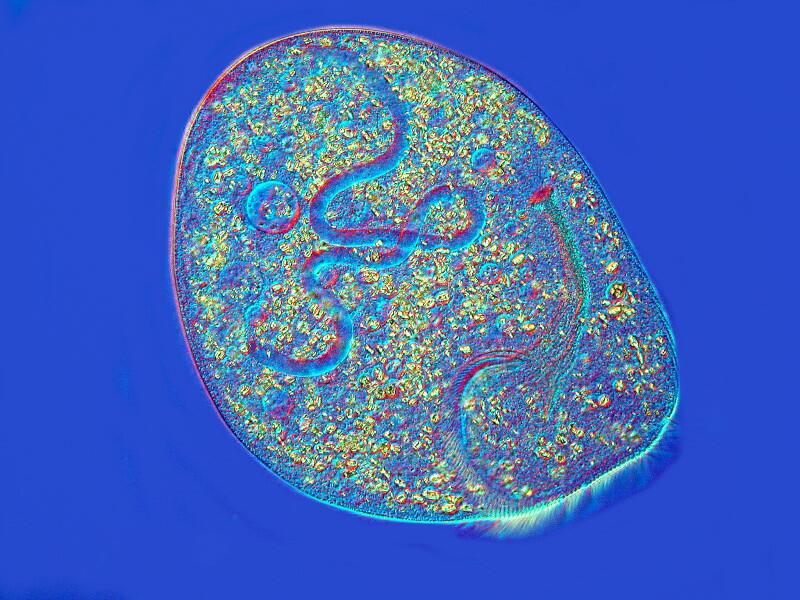
As you can see, this technique can, with practice, patience, and luck produce remarkable detail and, in this case, the cytostome, the macronucleus, and the birefringent crystals are especially striking.
Blepharisma is more of a challenge in terms of getting revealing images but, in some ways, it is an even more intriguing organism. It has a bundle of bizarre characteristics and behaviors. First of all, most species contain a unique pink pigment, aptly named blepharismin, which has some extraordinary properties: 1) it is a photoactive pigment and apparently, in nature, helps the organism regulate its position in the water column so that it remains out of the upper layers with the most intense sunlight and a bit farther down where its food sources are most abundant. This, when one thinks about it, is an amazing adaptive strategy but, there is more. It turns out that this pigment is toxic to some other organisms if they devour very many Blepharisma. And here’s where things get interesting and complicated. If there is some sort of biochemical signal which the Blepharisma releases via the pigment, then one would think that that would trigger an avoidance response on the part of the predator but, who knows, maybe it tastes like chocolate and they can’t resist it. Or is it possible that some protists and lower invertebrates can “learn” from their experience and, if they survive, learn to avoid this pink beastie? Or, here’s an even wilder suggestion: perhaps some of the predators not only “learn”, but are even able to pass on such information, genetically, of course, to the progeny. I know that this smacks of some sort of Lamarckian heresy but, remember that we anthropoids often tend to view the world through the lens of vertebrates. We now know that bacteria can incorporate random genetic material from other species and produce weird combinations that survive, some in a manner which is threatening to us and other vertebrates. We have made considerable progress in understanding the mysteries of genetics, but nature is devious, tricky, even Machiavellian and we still have an enormous amount to learn.
Here are a couple of other little twists regarding Blepharisma.: 1) Under certain conditions, these lovely, pink critters turn cannibalistic and form what are know as “cannibal giants”. Apparently Blepharisma eating Blepharisma creates a major obesity problem. First of all, let’s take a look at a group of Blepharisma in a culture dish and here you can notice a size variation.
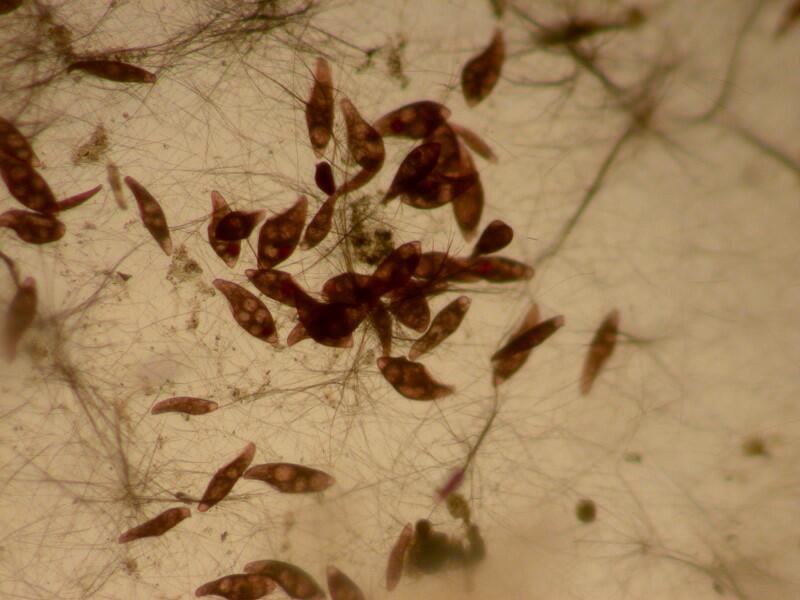
And here is a cannibal giant:
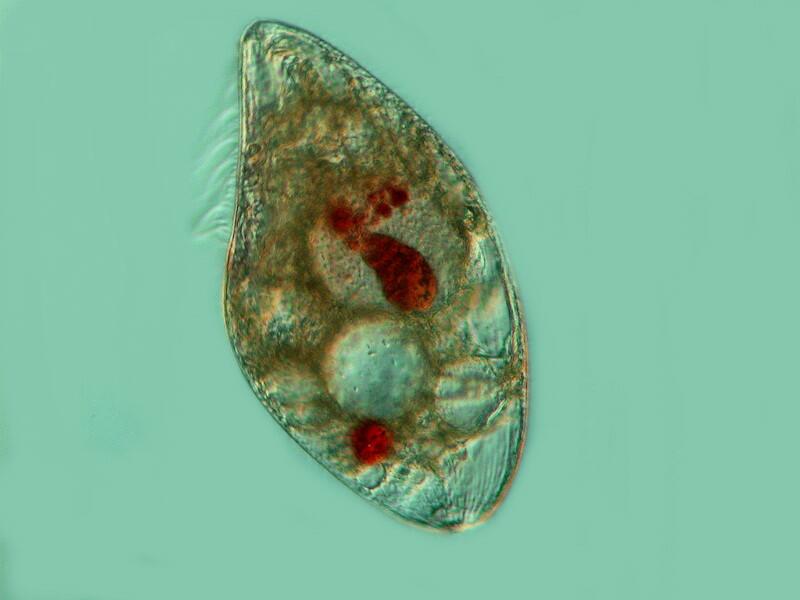
Notice how a food vacuole containing a now “compacted” Blepharisma is a vivid, deep red and no long just pink. No one is certain what triggers such behavior. Several theories have been put forward: a) a shortage of its usual food which from observations doesn’t seem terribly likely since I have found them in cultures where food is abundant. b) Overcrowding. Again this seems dubious, since similar population densities in other culture dishes don’t trigger cannibalism. c) Too much toxic waste from their own excretions. It could be that a biochemical trigger is produced “warning” the organisms of the potential of food shortage in the very near future. Again doubtful but, if true, it would be a splendid illustration of “survival of the fittest”. d) My own theory is that there are some Blepharisma that contain a genocide gene and that they are driven by an urge for world domination. Actually, the first part of that is not as farfetched as it might sound. There is a strain of Paramecium aurelia which contains either a viroid or some aberrant genetic fragment called a Kappa particle. When this strain conjugates with non-Kappa strains, some of these particles are transmitted during the exchange of micronuclei. As it turns out, the Kappa particles are lethal to the non-Kappa strains, thus increasing the dominance of the Kappa strain–sounds a lot like football and war. An intriguing aspect of the cannibalism problem is that we don’t even know for certain that such behavior occurs in nature or whether something in the artificial environment of a laboratory dish triggers it.
And now, here are two views of Blepharisma in their “normal” non-giant stage.
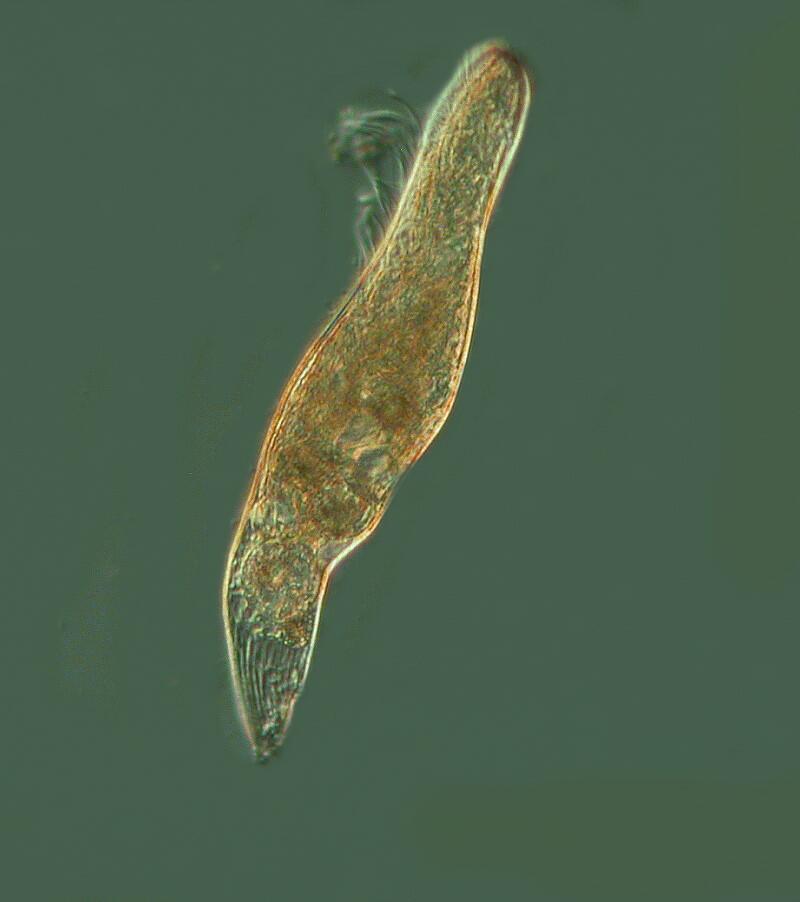
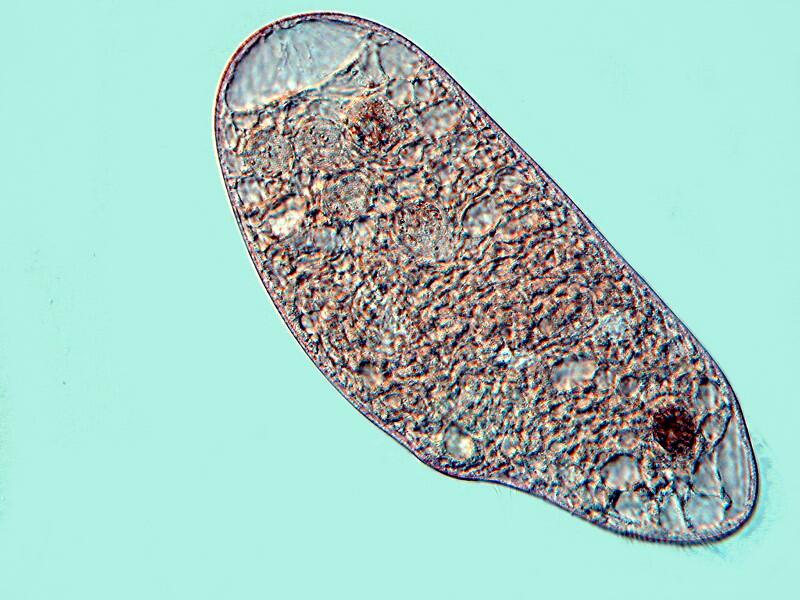
2) I mentioned a second little twist. There are some strains of Blepharisma that are not pink, but are blue and others which are albino. Nature just loves to mess with our minds; we think we have something all neatly figured out and then we discover new wrinkles and wrinkles within wrinkles.
Oh, and by the way, Blepharisma has an undulating membrane around the cytostome. If you want a challenge, try getting a good photomicrograph of that. In addition, there are certain ciliates which have a silverline system which can be revealed only by the use of special staining techniques. The specimen below showing the silverline system was achieve using a complex method involving Protargol, and organic silver compound.
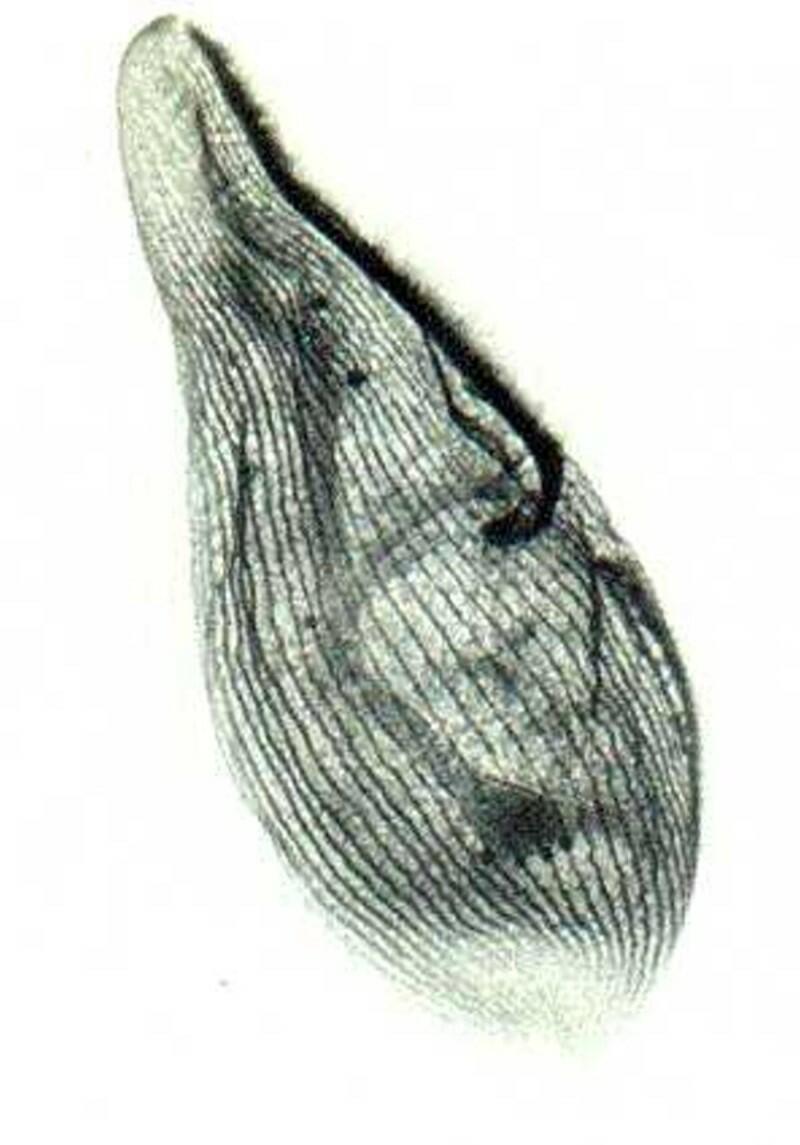
Fortunately, Blepharisma has very distinctive cysts and if you find some, you can culture them and try to solve some of these marvelous mysteries yourself. Here’s what the cysts look like, so be on the lookout. The first image is a close-up and the second shows a cluster of cysts.
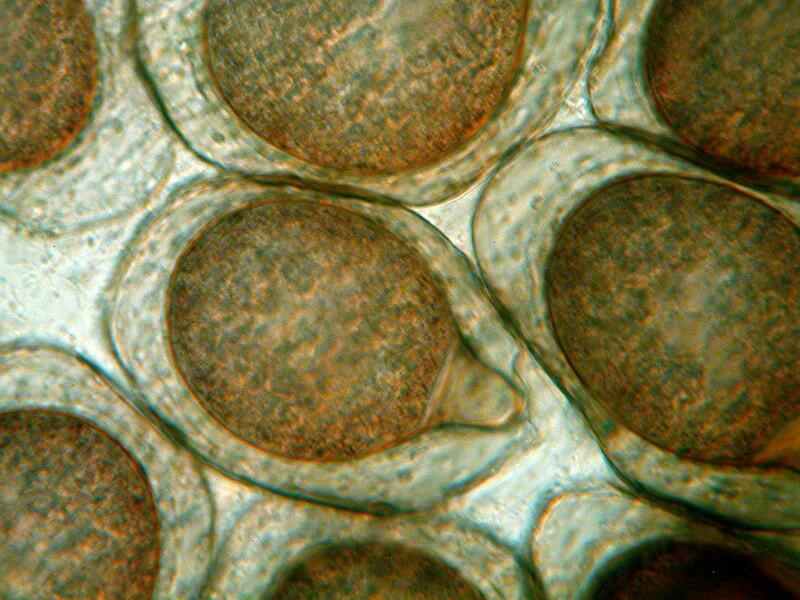
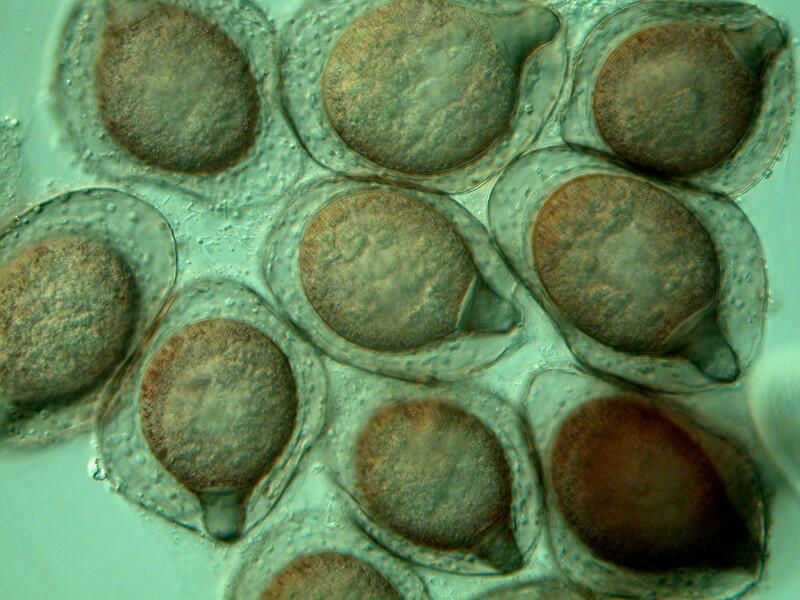
You will notice that they actually go through several stages of development, but the final and most distinctive one is that in which it appears that the organism has a proboscis and in overall appearance is somewhat like the voracious ciliate Didinium.
All comments to the author Richard Howey are welcomed.
Editor's note: Visit Richard Howey's new website at http://rhowey.googlepages.com/home where he plans to share aspects of his wide interests.
Microscopy UK Front
Page
Micscape
Magazine
Article
Library
Please report any Web problems or offer general comments to the Micscape Editor .
Micscape is the on-line monthly magazine of the Microscopy UK website at Microscopy-UK .